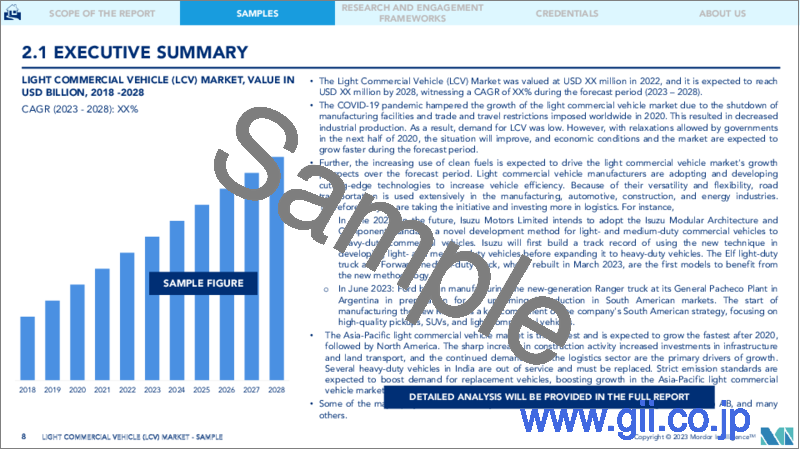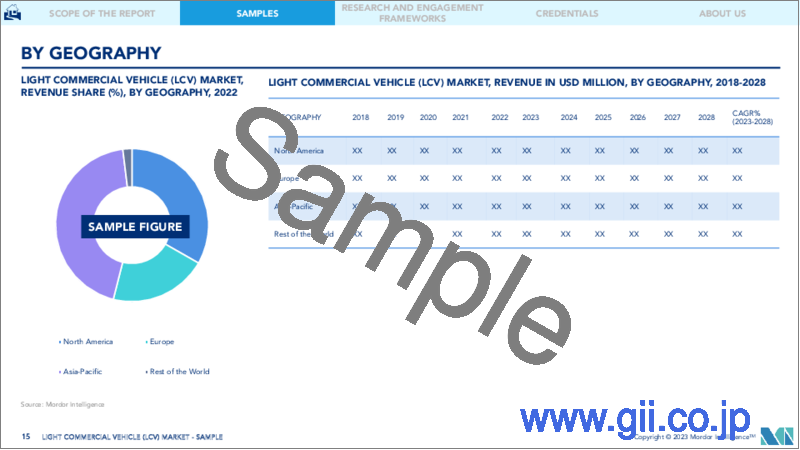|
|
市場調査レポート
商品コード
1197417
小型商用車(LCV)市場- 成長、動向、予測(2023-2028)Light Commercial Vehicle (LCV) Market - Growth, Trends, and Forecasts (2023 - 2028) |
||||||
|
● お客様のご希望に応じて、既存データの加工や未掲載情報(例:国別セグメント)の追加などの対応が可能です。 詳細はお問い合わせください。 |
|||||||
| 小型商用車(LCV)市場- 成長、動向、予測(2023-2028) |
|
出版日: 2023年01月23日
発行: Mordor Intelligence
ページ情報: 英文 90 Pages
納期: 2~3営業日
|
- 全表示
- 概要
- 目次
小型商用車市場は現在5,425億3,000万米ドルとなり、今後5年の間に約7.02%のCAGRで推移すると予想されています。
COVID-19の大流行とそれに伴う封鎖、物資の移動制限は、市場に悪影響を及ぼしました。例えば、国際労働機関(ILO)のデータによると、COVID-19の流行期間中、道路貨物産業の収益は40%減少しました。さらに、自動車生産の落ち込みと労働力不足は、市場に大きな影響を与えました。しかし、自動車業界では2020年後半に小型商用車の販売台数が増加し、2021年中もそれが続きました。パンデミック後、メーカーは自動車産業の重要なセクターの顧客との継続性を保持するために、将来のビジネスの不確実性を軽減するためのコンティンジェンシー・プランを実施しています。
長期的には、自動車の排出ガスに関する規制の強化、自動車の安全性の高度化、自動車への運転支援システムの導入、小売・eコマース分野における物流の急成長が、新型・先進商用車の需要を大きく押し上げています。また、物流やeコマース産業が急成長していることから、LCVの需要も増加すると思われます。さらに、急速な都市化により、効率的な物流を必要とする新たな小売・eコマースのプラットフォームが生まれ、小型商用車(LCV)市場の成長につながっています。
電動モビリティへの移行は、大手企業による電気自動車の採用が加速しているため、小型商用車の需要をさらに高めています。大手メーカーも他の大手企業との提携により、予測期間中に既存の大多数のエンジン式小型商用車を電動化するために、いくつかの製品を提供しています。
主要企業は、拡大する小型商用車の需要に対応するため、新しい電動小型商用車を発売し、生産能力拡大に投資しています。例えば
主なハイライト
- 2022年9月、Daimler Truck SEの日本法人であるFUSOは、次世代電動小型商用車eCanterを発売しました。この最新世代eCanterの日本での販売開始は、2023年春を予定しています。
- 2021年12月、電動ピックアップトラックとSUVのメーカーであるリビアン・オートモーティブは、50億米ドルを投じて米国ジョージア州のモーガン郡とウォルトン郡に第2製造拠点を設置すると発表しました。同工場は、2024年の操業開始時に年間生産台数40万台、従業員数7,500人を予定しています。
また、小型商用車市場の成長を牽引しているのは、フリートの拡大に大きな投資を行っているeコマース企業からの大量受注です。例えば
主なハイライト
- 2022年10月、アマゾンは今後5年間で10億ユーロ(10.4億米ドル)を投じて、欧州で電気トラックと配送バンを調達すると発表しました。
- 2022年1月、アマゾンはステランティスNVに数千台のラムプロマスターバッテリー電気自動車を発注しました。Ram ProMaster Battery Electric Vehicleは2023年に発売され、アマゾンはこの車両の最初の機関投資家顧客となる予定です。
北米は、小型商用車OEMの存在感が大きく、米国とカナダの自動車市場でピックアップトラックが優位にあることから、世界最大の小型商用車市場になると予想されます。
ASEANではピックアップトラック、インド、中国、韓国では小型トラック、欧州では都市内貨物輸送にデリバリーバンが主流であること、多くの小型商用車OEMが存在すること、eコマースや物流企業からの需要が高まっていることから、アジア太平洋と欧州が次の大きな市場になると予想されます。
このように、上記の要因がすべて重なることで、世界の小型商用車市場の成長が促進されると予測されます。
小型商用車(LCV)市場の動向
小型商用車の電動化が成長機会をもたらす見込み
ロジスティクスやサプライチェーン産業といったセクターの驚異的な成長により、多くの新興市場において電気自動車の採用が顕著になっています。2021年、米国ではeコマース部門が8,700億米ドルのGMV(Gross Merchant Value)に成長し、2020年から前年比14.2%の成長を記録しました。同分野で事業を展開する複数の企業が電気自動車の保有に注力しており、これが予測期間中の市場を牽引する可能性が高いです。
また、世界各国における厳しい排出規制や電気自動車目標の採用が、多くの企業に車両の電動化を促しており、これも市場の成長に重要な役割を担っています。例えば、2022年10月、EUは2035年からICエンジン車の新車販売を禁止する決議を採択しました。そのため、欧州のほぼすべての物流・郵便・eコマース企業は、電気自動車OEMから大規模に電気自動車を調達し、保有車両の電化を進めています。
大手物流、郵便、eコマース企業は、すでに保有する車両をすべて電気自動車に切り替えることを発表しています。これらの企業は、市場の主要なプレーヤーに注文を出し、車両を調達しています。例えば、次のようなことです。
- 2022年8月、英国のロイヤルメールは、ラストマイル配送用に3,000台目の電気バンを配備した後、さらに2,000台の電気バンを発注しました。この注文は、Stellantis NVのPeugeot PartnerとPeugeot Expertの電気版モデルを均等に割り当てています。
- 2022年7月、ウォルマートはラストマイル配送車両の電動化計画の一環として、電気バンメーカーのカヌーに4,500台の電気配送バンを発注しました。
- 2022年2月には、ノルウェーポストがボルボFEとボルボFLの電気トラック29台を発注しています。
小型電気商用車(LECV)を車両群に加えることで、別便・小包ネットワークで3%の流通コスト削減につながったことが確認されています。大規模な車両を保有する企業や組織は、リースではなく電気自動車を購入することを好んでいます。
政府の規制、電気自動車に対する金融優遇措置、電気自動車をサポートするインフラの迅速な構築は、予測期間中に調査された市場を押し上げるでしょう。
米国と中国がLCV市場をリードする可能性が高い
中国のeコマース業界は継続的に成長しており、それが同国のLCV業界を牽引しています。例えば、アリババグループ、テンセント、JD.comなどの地元テクノロジー企業が、中国で急成長しているeコマースエコシステムを支配しています。中国では、昨年の小売eコマースからの収益はおよそ1兆3684億5700万米ドルで、前年比8.5%の伸びと推定され、2020年にはおよそ1兆2640億200万米ドルになるとされています。この要因がLCV市場の成長を牽引することが予想されます。
市場は力強く成長し、欧州スタイルのコンパクトバンや商用車に引き寄せられています。都市化の進展とeコマースのブームにより、都心部では人とモノの両面において物流の最適化と新たな輸送計画が求められています。都市部におけるファイナルマイル配送は、2022年から2030年の間に125%増加すると予想されています。小型商用車は、主に短距離の物品運搬に使用されます。物流やeコマース産業が急成長しているため、LCVの需要は増加すると思われます。急速な都市化により、効率的な物流を必要とする新しい小売やeコマースのプラットフォームが生まれ、小型商用車(LCV)市場の成長につながっています。
米国政府が軽自動車に分類する車両には、スポーツ・ユーティリティ・ビークル、バン、ピックアップ・トラック、多目的車などがあります。2021年12月の米国の軽自動車販売台数は1,221,647台と発表されており、ピックアップトラックの販売台数の伸びが大きく影響しています。
ピックアップトラックは、ほとんどの米国人が楽しんでいる冒険的なライフスタイル、DIY運搬セグメントにおける短距離の物品運搬におけるピックアップトラックの多用途性、電気技師、配管工、大工、農家、小規模建設業者などの自営業者の多くが、主に専門的要件のためにピックアップトラックを購入し、ピックアップトラックとSUVが他の車種よりも男らしいイメージを米国の一般車両購入者の心の中で描くことから、米国で最も販売されているタイプの小型商用車であると言えます。
Rivian R1T、Ford F150 Lightning、Chevrolet Silverado EVなどの電動ピックアップトラックの導入は、今後5年間の米国におけるピックアップトラックの販売をさらに促進することが期待されます。
このように、前述の要因により、米国と中国が予測期間中、世界最大の小型商用車市場であり続けると予想されます。
小型商用車(LCV)市場の競合他社分析
小型商用車は、インド、中国、日本、韓国といった市場の一部のローカルプレーヤーと、世界プレーヤーによって高度に統合され、支配されています。主要プレイヤーには、General Motors Company、Toyota Motor Corporation、Ford Motor Company、Stellantis NV、Daimler Truck SEなどがあります。
LCVメーカーは、新製品や新技術の開発、生産能力の拡大、新たな合弁事業やM&Aを行い、競争力を高め、市場での存在感を維持しようとしています。例えば、以下のようなことです。
- 2022年10月、General Motors CompanyのブランドであるGMCは、1回のフル充電での航続距離が640km、牽引力が4309kgの初の電動ピックアップトラックGMC Sierra EVを発売しました。
- 2022年9月には、Stellantis NVの子会社であるCNH Industrialの商用車ブランドであるIvecoが、電気バン「eDaily」を発売しました。最大車両総重量7.2トン、積載量4.6トン、牽引力3.5トンで販売予定。
- 2022年9月、メルセデス・ベンツAGとリビアン・オートモーティブは、欧州における電気バンの生産で協力する戦略的パートナーシップを締結しました。このパートナーシップの目的は、中・東欧にある既存のメルセデス・ベンツの拠点を活用して、全く新しい電気専用生産施設を建設することです。
- 2022年5月、Stellantis NVとトヨタ自動車は、StellantisがイタリアとポーランドのStellantis工場でトヨタ向けの大型商用バンを生産する契約を締結しました。トヨタは2024年から欧州でこのバンを自社ブランドで販売します。
- 2022年3月、Daimler AGは、新型ディーゼルエンジンとAWDシステムを搭載した2023年型Sprinter Vanをデビューさせました。新エンジンは208psを発生し、2023年初頭までに米国で販売される予定です。
その他の特典です。
- エクセル形式の市場予測(ME)シート
- アナリストによる3ヶ月間のサポート
目次
第1章 イントロダクション
- 調査の前提条件
- 調査範囲
第2章 調査手法
第3章 エグゼクティブサマリー
第4章 市場力学
- 市場促進要因
- 市場抑制要因
- ポーターのファイブフォース分析
- 新規参入業者の脅威
- 買い手/消費者の交渉力
- 供給企業の交渉力
- 代替品の脅威
- 競争企業間の敵対関係
第5章 市場セグメンテーション
- 車種別
- 乗用バン
- カーゴバン
- ピックアップトラック
- その他車両タイプ
- トン数別
- 2.5トン未満
- 2.5トン以上3.5トン未満
- 3.5トン以上
- 燃料別
- ガソリン
- ディーゼル
- 代替燃料
- 電気自動車
- 地域別
- 北米
- 米国
- カナダ
- その他北米地域
- 欧州
- ドイツ
- 英国
- フランス
- その他の欧州地域
- アジア太平洋地域
- インド
- 中国
- 日本
- 韓国
- その他アジア太平洋地域
- 世界のその他の地域
- ブラジル
- アルゼンチン
- アラブ首長国連邦
- メキシコ
- その他の国
- 北米
第6章 競合情勢
- ベンダーの市場シェア
- 企業プロファイル
- Daimler AG
- Renault SA
- Volkswagen AG
- Volvo AB
- Ford Motor Company
- Ashok Leyland Ltd
- Tata Motors Ltd
- Mahindra & Mahindra Ltd
- VE Commercial Vehicles Limited
- SML Isuzu Limited
- Stellantis NV
- General Motors
- Toyota Motor Corporation
第7章 市場機会と今後の動向
The light commercial vehicle market is currently valued at USD 542.53 billion, and it is expected to register a CAGR of about 7.02% over the next five years.
The outbreak of the COVID-19 pandemic and the associated lockdown and restricted movement of goods impacted the market adversely. For instance, according to the data from the International Labor Organisation (ILO), during the COVID-19 pandemic, the revenues of the road freight industry declined by 40%. Furthermore, the fall in automotive production and lack of labor significantly impacted the market. However, the automotive industry witnessed a growth in light commercial vehicle sales in the second half of 2020, and it continued during 2021 as well. Post-pandemic, the manufacturers are implementing contingency plans to mitigate future business uncertainties to retain continuity with clients in the critical sectors of the automobile industry.
Over the long term, increasing regulations on vehicle emissions, advancement in vehicle safety, the introduction of driver-assist systems in vehicles, and rapidly growing logistics in the retail and e-commerce sectors have been significantly driving the demand for new and advanced commercial vehicles. The demand for LCVs is likely to increase as the logistics and e-commerce industries are growing rapidly. Additionally, rapid urbanization has created new retail and e-commerce platforms, which require efficient logistics, leading to the growth of the light commercial vehicles (LCV) market.
The transition toward electric mobility further increases the demand for light commercial vehicles, owing to the faster adoption of electric vehicles by major companies. Large-scale manufacturers are also offering several products, in partnerships with other major companies, to transform the existing majority of engine-powered light commercial vehicles to electric over the forecast period.
Key players are launching new electric light commercial vehicles and investing in capacity expansion to address the growing demand for electric light commercial vehicles. For instance
Key Highlights
- In September 2022, FUSO, the Japanese subsidiary of Daimler Truck SE, launched the next generation of electric eCanter light commercial vehicles. The sales of this latest generation of eCanter vehicles are scheduled to begin in Japan in the spring of 2023.
- In December 2021, Rivian Automotive, a manufacturer of electric pickup trucks and SUVs, announced investing USD 5 billion to set up its second manufacturing facility at Morgan and Walton counties in Georgia, United States. The plant will have an annual production of 400,000 vehicles and will employ 7,500 people when the plant begins operations in 2024.
The growth in the market for light commercial vehicles is also being driven by the large orders from e-commerce companies that are investing majorly in fleet expansion. For instance,
Key Highlights
- In October 2022, Amazon announced it to spend EUR 1 billion (USD 1.04 billion) to procure electric trucks and delivery vans over the next five years in Europe.
- In January 2022, Amazon placed an order for thousands of units of Ram ProMaster Battery Electric Vehicles from Stellantis NV. Ram ProMaster Battery Electric Vehicle will be launched in 2023, and Amazon will be the first institutional customer for the vehicle.
North America is anticipated to be the largest market for light commercial vehicles in the world due to the large presence of light commercial vehicle OEMs and the dominance of pickup trucks in the automotive markets of the United States and Canada.
Asia-Pacific and Europe are forecasted to be the next biggest markets because of the dominance of pickup trucks in ASEAN, small trucks in India, China, and South Korea, and delivery vans in Europe for intracity freight transportation, the presence of many light commercial vehicle OEMs, and rising demand from the e-commerce and logistics companies.
Thus, the confluence of all the above factors is predicted to propel growth in the light commercial vehicle market worldwide.
Light Commercial Vehicle (LCV) Market Trends
Electrification of Light Commercial Vehicles Likely to Bring Growth Opportunities
Due to the tremendous growth among sectors like logistics and supply chain industries, the adoption of electric vehicles is quite evident in many emerging markets. In 2021, the e-commerce sector grew to a Gross Merchant Value (GMV) of USD 870 billion in the United States, registering a YoY growth of 14.2% from 2020. Several companies operating in the sector are focused on having an electric vehicle fleet, which is likely to drive the market during the forecast period.
In addition, the adoption of stringent emission norms and electric vehicle targets in countries worldwide are pushing many companies to electrify their fleet, which is also playing a crucial role in the market's growth. For instance, in October 2022, the EU passed the resolution to ban the sales of new IC engine vehicles from 2035. Thus, almost all the logistics, postal, and e-commerce companies in Europe are electrifying their fleets by procuring electric vehicles on a large scale from the electric vehicle OEMs.
Big logistics, postal, and e-commerce companies have already announced to turn their entire fleets to electric. The companies have been placing orders with key players in the market to source the vehicles. For instance,
- In August 2022, Royal Mail of the United Kingdom ordered another 2,000 units of electric vans after deploying its 3,000th electric van for last-mile deliveries. The order is evenly split for electric versions of the Peugeot Partner and Peugeot Expert models from Stellantis NV.
- In July 2022, Walmart ordered 4,500 electric delivery vans from Canoo, an electric van manufacturer, as a part of its plans to electrify its last-mile delivery fleet.
- In February 2022, Norwegian Post placed an order for 29 units of Volvo FE and Volvo FL electric trucks.
It has been identified that adding light electric commercial vehicles (LECV) to the vehicle fleet led to a distribution cost saving of 3% in the separate mail and parcel network. Companies and organizations with large fleets prefer to buy electric vehicles instead of leasing them.
The government regulations, financial incentives toward electric vehicles, and the quick establishment of infrastructure supporting EVs would boost the market studied during the forecast period.
United States and China are likely to Lead the LCV Market
The Chinese e-commerce industry is continuously growing, which is driving the LCV industry in the country. For instance, Local technology companies such as Alibaba Group, Tencent, and JD.com are dominating a rapidly growing e-commerce ecosystem in the country. In China, revenue from retail e-commerce was estimated at roughly USD 1,368.457 billion last year, with a YoY growth of 8.5%, while in 2020, it was around USD 1,260.402 billion. This factor is expected to drive the LCV market's growth.
The market is growing strongly and gravitating toward European-style compact vans and commercial vehicles. Increased urbanization and the boom in e-commerce call for optimized logistics and new transport plans in city centers, both for people and goods. Final-mile deliveries in urban areas are expected to increase by 125% between 2022 and 2030. Light commercial vehicles are largely used for carrying goods for shorter distances. The demand for LCVs is likely to increase as the logistics and e-commerce industries are growing rapidly. Rapid urbanization has created new retail and e-commerce platforms that require efficient logistics, leading to the growth of the light commercial vehicles (LCV) market.
The vehicles classified by the US government under light vehicles include Sports Utility Vehicles, Vans, Pick-up Trucks, and Multi-purpose Vehicles. In December 2021, the light vehicle sales in the United States were reported to be 1,221,647 units, driven largely by the growth in the sales of pickup trucks.
Pickup trucks are the most sold type of light commercial vehicles in the United States due to the adventure lifestyle enjoyed by most Americans, the versatility of pickup trucks in hauling goods over short distances in the DIY hauling segment, the large number of self-employed professionals like electricians, plumbers, carpenters, farmers, and small contractors who buy pickup trucks mainly for their professional requirements and the masculine image the pickup trucks and SUVs portray over another type of vehicles in the minds of the average American vehicle buyers.
The introduction of electric pickup trucks like Rivian R1T, Ford F150 Lightning, and Chevrolet Silverado EV are further expected to drive the sales of pickup trucks over the next five years in the United States.
Thus, the United States and China are anticipated to remain the largest markets for light commercial vehicles in the world over the forecast period due to the aforementioned factors.
Light Commercial Vehicle (LCV) Market Competitor Analysis
The light commercial vehicle is highly consolidated and dominated by global players, with some local players in markets like India, China, Japan, and South Korea. Some of the major players include General Motors Company, Toyota Motor Corporation, Ford Motor Company, Stellantis NV, and Daimler Truck SE.
LCV manufacturers are developing new products and technologies, expanding their production capacities, and engaging in new joint ventures and mergers and acquisitions to increase their competitiveness and stay relevant in the market. For instance,
- In October 2022, GMC, a brand of General Motors Company, launched its first electric pickup truck GMC Sierra EV, which has 640km of range on a single full charge and a towing capacity of 4,309kg.
- In September 2022, Iveco, the commercial vehicle brand of CNH Industrial, a subsidiary of Stellantis NV, launched the eDaily electric van. The van will be available at up to 7.2 tonnes GVW enabling a 4.6-tonne payload and 3.5-tonne towing capability.
- In September 2022, Mercedes Benz AG and Rivian Automotive signed a strategic partnership to cooperate on the production of electric vans in Europe. The purpose of the partnership is to build an all-new electric-only production facility leveraging an existing Mercedes Benz site in Central/Eastern Europe.
- In May 2022, Stellantis NV and Toyota Motor Corp. signed an agreement that will see Stellantis manufacturing large commercial vans for Toyota at Stellantis' plants in Italy and Poland. Toyota will sell these vans under its own brand in Europe starting in 2024.
- In March 2022, Daimler AG debuted its 2023 Sprinter Van with a new diesel engine and an AWD system. The new engine produces 208 hp, and it is expected to go on sale in the United States by early 2023.
Additional Benefits:
- The market estimate (ME) sheet in Excel format
- 3 months of analyst support
TABLE OF CONTENTS
1 INTRODUCTION
- 1.1 Study Assumptions
- 1.2 Scope of the Study
2 RESEARCH METHODOLOGY
3 EXECUTIVE SUMMARY
4 MARKET DYNAMICS
- 4.1 Market Drivers
- 4.2 Market Restraints
- 4.3 Porter's Five Forces Analysis
- 4.3.1 Threat of New Entrants
- 4.3.2 Bargaining Power of Buyers/Consumers
- 4.3.3 Bargaining Power of Suppliers
- 4.3.4 Threat of Substitute Products
- 4.3.5 Intensity of Competitive Rivalry
5 MARKET SEGMENTATION
- 5.1 By Vehicle Type
- 5.1.1 Passenger Van
- 5.1.2 Cargo Van
- 5.1.3 Pickup Truck
- 5.1.4 Other Types of Vehicle
- 5.2 By Tonnage Capacity Type
- 5.2.1 Less Than 2.5 Tons
- 5.2.2 2.5 To 3.5 Tons
- 5.2.3 More Than 3.5 Tons
- 5.3 By Fuel Type
- 5.3.1 Gasoline
- 5.3.2 Diesel
- 5.3.3 Alternative Fuels
- 5.3.4 Electric
- 5.4 Geography
- 5.4.1 North America
- 5.4.1.1 United States
- 5.4.1.2 Canada
- 5.4.1.3 Rest of North America
- 5.4.2 Europe
- 5.4.2.1 Germany
- 5.4.2.2 United Kingdom
- 5.4.2.3 France
- 5.4.2.4 Rest of Europe
- 5.4.3 Asia-Pacific
- 5.4.3.1 India
- 5.4.3.2 China
- 5.4.3.3 Japan
- 5.4.3.4 South Korea
- 5.4.3.5 Rest of Asia-Pacific
- 5.4.4 Rest of the World
- 5.4.4.1 Brazil
- 5.4.4.2 Argentina
- 5.4.4.3 United Arab Emirates
- 5.4.4.4 Mexico
- 5.4.4.5 Other Countries
- 5.4.1 North America
6 COMPETITIVE LANDSCAPE
- 6.1 Vendor Market Share
- 6.2 Company Profiles*
- 6.2.1 Daimler AG
- 6.2.2 Renault SA
- 6.2.3 Volkswagen AG
- 6.2.4 Volvo AB
- 6.2.5 Ford Motor Company
- 6.2.6 Ashok Leyland Ltd
- 6.2.7 Tata Motors Ltd
- 6.2.8 Mahindra & Mahindra Ltd
- 6.2.9 VE Commercial Vehicles Limited
- 6.2.10 SML Isuzu Limited
- 6.2.11 Stellantis NV
- 6.2.12 General Motors
- 6.2.13 Toyota Motor Corporation




